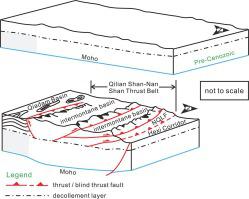当前位置:
X-MOL 学术
›
J. Asian Earth Sci.
›
论文详情
Our official English website, www.x-mol.net, welcomes your feedback! (Note: you will need to create a separate account there.)
Shortening of lower crust beneath the NE Tibetan plateau
Journal of Asian Earth Sciences ( IF 3 ) Pub Date : 2020-08-01 , DOI: 10.1016/j.jseaes.2020.104313 Xingfu Huang , Xiao Xu , Rui Gao , Xiaoyu Guo , Wenhui Li
Journal of Asian Earth Sciences ( IF 3 ) Pub Date : 2020-08-01 , DOI: 10.1016/j.jseaes.2020.104313 Xingfu Huang , Xiao Xu , Rui Gao , Xiaoyu Guo , Wenhui Li

|
Abstract We reprocessed a high-resolution deep seismic reflection profile to reveal the detailed crustal structure of the junction between the Qilian Shan-Nan Shan thrust belt and the Hexi Corridor basin in the NE Tibetan Plateau. The profile shows that the Moho discontinuity is characterized by complex dislocations and overlapping geometries. Restoration of the deformed Moho discontinuity reveals 50.2 km (35.5%) of Cenozoic lower-crustal shortening along the seismic profile. Compression of the lower crust produces crustal thickening of ~12.8 km. This demonstrates that lower-crustal shortening plays a significant role in topographic uplift and crustal thickening at the NE margin of the Tibetan Plateau. Thus, we propose a double-layered shortening mechanism, with decoupled deformation of upper crust and lower crust. The proposed deformation mechanism differs from previous crustal shortening models for the northern, eastern, and northeastern Tibetan Plateau. Our model eliminates the need for lower-crustal flow to explain topographic uplift along the NE margin of the Tibetan Plateau.
中文翻译:

青藏高原东北部下地壳缩短
摘要 我们对高分辨率深地震反射剖面进行了再处理,揭示了青藏高原东北部祁连山-南山冲断带与河西走廊盆地交汇处的详细地壳结构。剖面图显示莫霍面不连续的特征是复杂的位错和重叠的几何形状。变形的莫霍面不连续面的恢复揭示了沿地震剖面 50.2 公里(35.5%)的新生代下地壳缩短。下地壳的压缩产生约 12.8 公里的地壳增厚。这表明下地壳缩短在青藏高原东北缘地形隆升和地壳增厚中起重要作用。因此,我们提出了一种双层缩短机制,上地壳和下地壳的变形解耦。提出的变形机制不同于以往青藏高原北部、东部和东北部的地壳缩短模型。我们的模型不需要下地壳流来解释青藏高原东北缘的地形隆升。
更新日期:2020-08-01
中文翻译:

青藏高原东北部下地壳缩短
摘要 我们对高分辨率深地震反射剖面进行了再处理,揭示了青藏高原东北部祁连山-南山冲断带与河西走廊盆地交汇处的详细地壳结构。剖面图显示莫霍面不连续的特征是复杂的位错和重叠的几何形状。变形的莫霍面不连续面的恢复揭示了沿地震剖面 50.2 公里(35.5%)的新生代下地壳缩短。下地壳的压缩产生约 12.8 公里的地壳增厚。这表明下地壳缩短在青藏高原东北缘地形隆升和地壳增厚中起重要作用。因此,我们提出了一种双层缩短机制,上地壳和下地壳的变形解耦。提出的变形机制不同于以往青藏高原北部、东部和东北部的地壳缩短模型。我们的模型不需要下地壳流来解释青藏高原东北缘的地形隆升。



























 京公网安备 11010802027423号
京公网安备 11010802027423号